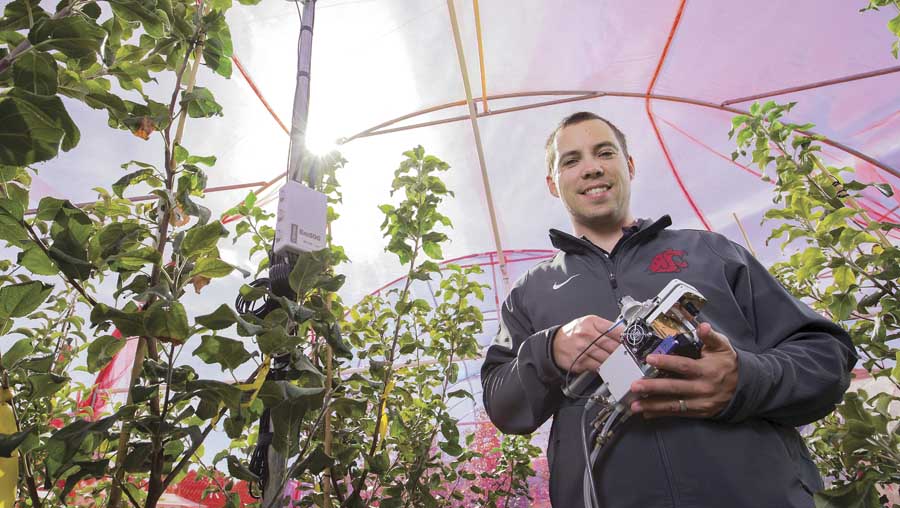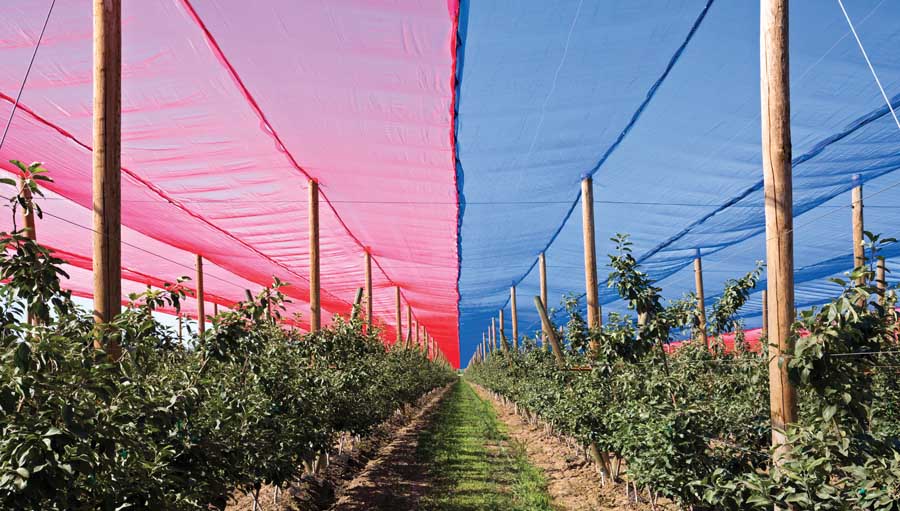
Dr. Lee Kalcsits stands under red netting while holding an instrument used to measure how trees react to different light spectrums at the WSU Tree Fruit Research Center. (TJ Mullinax/Good Fruit Grower)
Central Washington State is known for breathtaking scenery, especially the greenery of vast orchards that flow from mountains into river valleys. But that view may radically change to red, blue, or pearl if growers decide to cover their acreage in colored nets.
Washington State University researchers are studying how netting in different colors addresses problems, such as sunburn and stress, that cost grower dollars.
Netting is already used in certain areas, especially in Europe, as protection from hail. Perhaps just 1,500 acres of Washington’s apple orchards are netted. But the WSU researchers are looking at netting for more widespread use, as replacement for overhead cooling systems that are often necessary in the Northwest’s climate of long days of intense sunlight.
The researchers are studying how nets of different colors affect the microclimate around a plant and affect plant physiology, production, and fruit quality and storability. To an untrained eye, the colors in the study look like a 4th of July array of simple red, blue, and white, but the whitish nets are actually a pearl hue. (Pure white reflects light; pearl allows more light to enter the canopy.)
Dr. Lee Kalcsits, plant physiologist with the WSU Tree Fruit Research and Extension Center in Wenatchee, recently spoke to Good Fruit Grower about the project, which also involves WSU researchers Dr. Stefano Musacchi, Dr. Desmond Layne, Dr. Sara Serra, and Tory Schmidt, research scientist with the Washington Tree Fruit Research Commission.
The research team will present their first round of findings in December at the Washington State Tree Fruit Association’s annual meeting in Yakima. Based on early results, Kalcsits is confident that many growers will begin using netting. “I think it has really good potential to at least complement overhead cooling systems to reduce sunburn,” he said.

Red and blue netting are suspended above Honeycrisp apples near Quincy, Washington. (TJ Mullinax/Good Fruit Grower)
The multi-year study is taking place at two locations in Washington, in Wenatchee at a research orchard of 6,000 square feet where Honeycrisp trees grow in 10-gallon pots; and about 30 minutes away, near Quincy, at a McDougall and Sons orchard, using 12 acres of Honeycrisp trees now in their third leaf. Sensors monitor temperature, heat, soil moisture, humidity, wind speed, light intensity and other factors. Uncovered trees serve as control for the experiment.
Project funding totals $410,000, representing grants from the Washington Tree Fruit Research Commission and the U.S. Department of Agriculture.
Researchers estimate that installing nets such as those used in the tests would vary in cost, depending on whether the system was installed at planting or later, spacing of posts, suppliers of materials, the skills of installers, and other factors. WSU researchers estimate costs of $9,000 to $12,000 per acre; one South African contractor claims he’s found ways to lower the cost to $5,000 an acre. Netting is made from a durable polypropylene, with a specialized polymer and pigment stabilizer so colors don’t fade.
Benefits from netting include reduced sunburn, eliminated hail risk, reduced bird damage, reduced wind, and other benefits to be identified in the project. For a high-value cultivar such as Honeycrisp, the netting could pay for itself just from saving an orchard from one episode of hail damage, Kalcsits says.
The red, blue, and pearl netting all reduce light by 22 percent. But each creates different spectrums that researchers are analyzing. Based on tree-fruit studies done in Israel, Italy, Chile, and Australia, scientists know red tends to promote fruit color. Blue reduces vegetative growth. Pearl improves the distribution of light. Some studies have also looked at how netting affects insects. Further studies are needed to more closely determine the economics of different cost scenarios.
Kalcsits and his team acknowledge that netting systems pose challenges beyond cost. Nets need to be retracted and rolled up each year during the winter to extend the life of the fabric. Excessive shading can dampen a tree’s productivity—although that is not considered a significant risk in Washington State’s intense light.
Kalcsits is confident netting is the future.
“Any of the growers I’ve talked to that are using it are happy with the results,” he says. “Some are reluctant to get rid of overhead cooling yet, but they are encouraged by the result.” •
– by O. Casey Corr






What color netting will be more suitable for citrus?